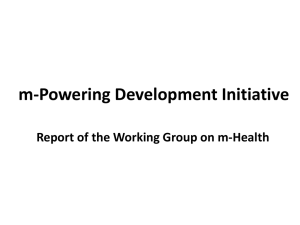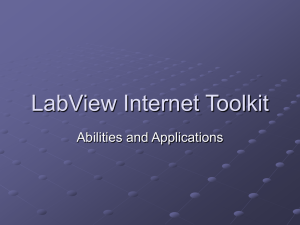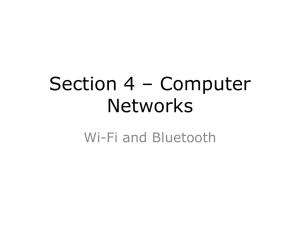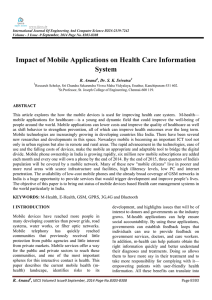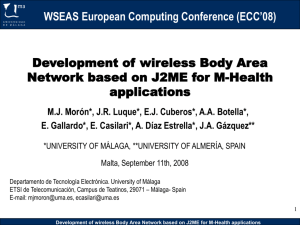M Health
advertisement
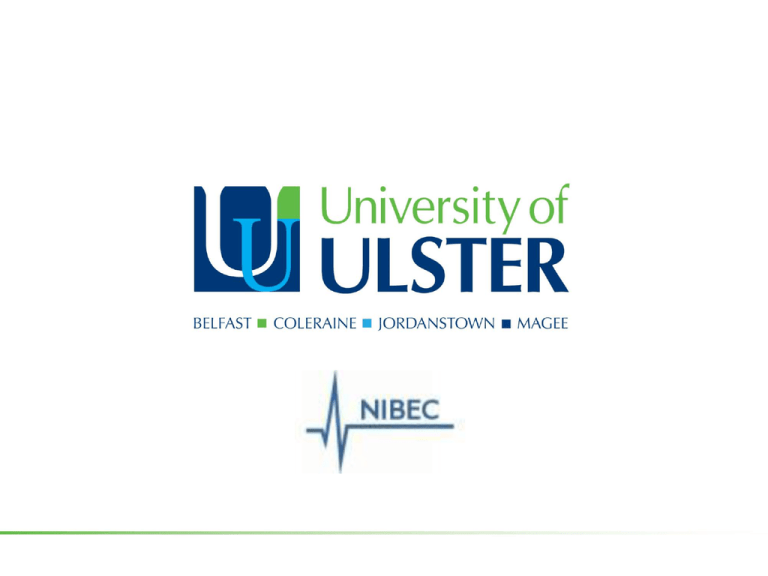
Capability study: Mobile Health at NIBEC Philip Catherwood (B.Eng.(Hons), MSc, PGCFHE). “m-Health has the potential to revolutionise affordable healthcare delivery by alleviating the systemic pressures on the healthcare industry”* * http://connectedplanetonline.com Why m-health promises to be a winning solution Low network maintenance Remote monitoring in rural areas Phones are always on, computers are not Carrying a Phone/Tablet is part of a modern lifestyle Using a small portable multi-communication computing device is convenient, economical, practical and personal m-health as a ‘developing world’ solution Examples of m-health initiatives – Argentina, Botswana, China, Guatemala, India, Indonesia, Kenya, Mozambique, Nigeria, Pakistan, Peru, Philippines, Rwanda, South Africa, Tanzania, Uganda, Zambia Issues include: Dealing with epidemics and a shortage of healthcare workers Largest killer diseases - malaria and AIDS Opportunities: explosive growth of mobile communications over the past decade offers a new hope for the promotion of quality healthcare Phones offer a management platform for administration and monitoring of anti-retroviral treatment programs Foundations to address the developing world’s health crisis set up by such philanthropists as Bill Gates m-health goals Develop patient-centered healthcare delivery Increased self-management of illness Alleviate the systemic pressures on the healthcare industry Reduced number of hospital beds occupied Remote monitoring and smart diagnosis Improved disease management Improved compliance with treatment regimes m-health at NIBEC Path of development includes: Select the wireless technology (e.g. Bluetooth, Wi-Fi, ZigBee). For telemetry solutions, connect Bluetooth (e.g. EBWT12-A), Wi-Fi (e.g. WiFly GSX 802.11b/g), ANT Ultra Low Power Wireless (e.g. Nordic Semiconductors) and/or ZigBee (e.g. CC2530ZDK) to microcontroller evaluation board or prototype device. For stand-alone solutions, choose suitable target smartphone and install necessary memory storage to meet the needs of the activity. Develop specification for the data capture, graphical user interface, plugin hardware and back-end network topology. Design and test software to meet the specification. Trial m-health solution based on quality of service requirements, customer specification and end-user ergonomics. 1 Phones We use a number of development phones; Those running Microsoft Windows Mobile for Pocket PC 2003 T-mobile MDA PH20B PocketPC HP iPAQ H5550 PocketPC Dell Axim X50 PocketPC -The above have SD slots, Bluetooth, IEEE802.11b, CPU Intel PXA263 400MHz, RAM 128MB. Those running Microsoft Windows Mobile for 6.5 Professional HTC HD2 T8585 Smartphone -The above has SD slots, Bluetooth, IEEE802.11b/g, GPS, CPU Qualcomm QSD8250 GHz, RAM 578MB. Tablet PCs Latest developments in computing technology have allowed clinicians to have the processing power of a desktop PC in a handheld mobile device. Platform boasts Bluetooth, Wi-Fi & LAN connectivity. Next generation will include 4G networking for synchronised rural roaming. Available wireless technology for m-health Bluetooth Radio module telemetry solution Wi-Fi Bluetooth mobile Labview Bluetooth mobile Labview Wi-Fi mobile Labview Wi-Fi mobile Labview Programming & GUI There are a number of ways to program phones & Tablets Windows mobile SDK (.NET using Visual C#) – professional programming activities for Windows mobile suite to generate commercial products Java mobile SDK (Java code, converted to JVM sitting on Linux kernel) – professional programming activities for Android mobile OS to generate commercial products Labview (G-programming) – rapid prototyping of concepts Develop GUI in National Instruments LabVIEW Examples of past, current and future projects Past – ECG onto portable device Modify and test embedded software on the hardware platform (add communication protocol). Alter the LabVIEW code (serial port information and wireless technology-specific protocols). Re-configure the LabVIEW code for the implementation of National Instruments LabVIEW Mobile 2009. Execute new software on mobile device and test functional operation. Current – Smartphone Point of care device Current – Smartphone/Ambulatory patient monitoring device integration Future – Many projects planned. A small selection include: ‘Developing world’ solutions (HIV testing, data collection, mobile medical centre devices, etc). Future Point of Care devices (Glucose monitoring, Asthma monitoring, etc). Continua Certification Growing Continua Alliance membership, with a focus on mobile communication for medicine. Increased integration due to wireless medical standardisation. Quality of Service and network integration (clinical trials) m-health solutions must provide a robust ‘always-up’ service. When the wireless connection is not available, the onboard memory must record and store the vital medical data and forward it at a time when connectivity is restored. m-health solutions must be suitably flexible to be integrate with current hospital technologies.
